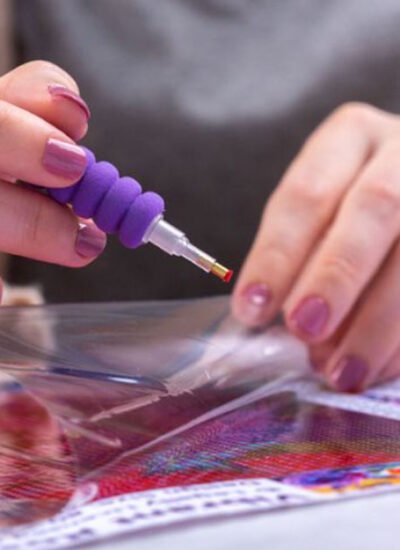 Your diamond painting is a work of art that reflects your creativity and attention to detail. Keeping it clean and well-maintained preserves its stunning beauty for years. Dust, moisture, and poor storage can dull the shine and even loosen the adhesive, ruining your hard work.
Your diamond painting is a work of art that reflects your creativity and attention to detail. Keeping it clean and well-maintained preserves its stunning beauty for years. Dust, moisture, and poor storage can dull the shine and even loosen the adhesive, ruining your hard work.
In this comprehensive guide, you will learn the best methods for cleaning and maintaining your diamond art painting. From the tools you need to common cleaning mistakes to avoid, we cover everything step-by-step.
Let us begin with understanding what happens when you do not maintain your masterpiece.
What Happens If You Do Not Maintain Your Diamond Painting?
Neglecting regular care can lead to several issues that affect the appearance and compromise the longevity of your diamond painting. Here is what you risk when maintenance is overlooked.
Dust Buildup and Dullness
Over time, dust particles settle on your canvas. If ignored, this can reduce the brilliance of the diamonds and make the entire piece look lifeless.
Risk of Adhesive Losing Its Stick
Diamond paintings rely on a sticky surface. Exposure to dirt, oils, or too much moisture may reduce the stickiness, causing diamonds to fall off or shift.
Long-Term Wear and Tear
Unprotected diamond paintings may suffer from wrinkles, folds, or peeling edges. Poor handling also increases the risk of physical damage.
Loss of Sparkle and Color Vibrancy
The shine and vibrant colors that make diamond art unique can fade if not properly cleaned and preserved. Proper care ensures your artwork stays eye-catching.
When Should You Clean Your Diamond Painting?
Cleaning your diamond painting at the right time helps keep it looking sharp and lasting longer. Here is when you should do it for the best results.
After Completing Your Artwork
This is the perfect time to gently clean off any dust or debris before you frame or seal.
During the Project
If you notice dirt, lint, or pet hair while working, it’s safe to remove it immediately using soft cleaning tools.
Before Sealing or Framing
Cleaning ensures that no foreign materials are trapped between the seal and the glass, which is essential for long-term protection.
Safe Tools You Will Need for Cleaning
Here are some safe and effective options to get the job done.
- Soft brushes: Use makeup brushes or anti-static brushes to gently lift dust.
- Microfiber cloth: Perfect for light wiping without scratching or leaving fibers.
- Gentle baby wipes or a damp cloth: Ideal for removing small smudges or stickiness.
- Tweezers: Help pick out debris or misplaced diamonds.
- Storage containers: Keep leftover drills safe and sorted to avoid mix-ups.
Step-by-Step Guide to Cleaning Your Diamond Painting
Now that you have the right tools, let us walk through a simple step-by-step process to safely clean your diamond painting without damaging it.
Step 1: Light Dusting for Regular Maintenance
Use a clean, soft brush to sweep across your canvas gently. Begin from one corner and move in one direction. This prevents particles from getting lodged deeper between the drills. Never press too hard, as this may dislodge diamonds.
Step 2: Removing Stains or Sticky Residue
If your canvas has fingerprints or sticky spots, lightly dab the area with a baby wipe or slightly damp microfiber cloth. Do not oversaturate. Let the area air dry completely before continuing work or sealing.
Step 3: What NOT to Use When Cleaning
Avoid using strong chemicals, alcohol-based cleaners, or abrasive cloths. These may damage the adhesive layer or scratch the resin diamonds. Also, never soak the canvas or apply water directly.
Discover Premium Diamond Painting Kits at Dreamer Designs
 When it comes to creating and preserving stunning diamond art, the quality of your materials matters just as much as your technique. So many crafters trust Dreamer Designs for premium diamond painting kits that deliver vibrant colors, long-lasting shine, and a flawless finish.
When it comes to creating and preserving stunning diamond art, the quality of your materials matters just as much as your technique. So many crafters trust Dreamer Designs for premium diamond painting kits that deliver vibrant colors, long-lasting shine, and a flawless finish.
Dreamer Designs offers a wide selection of full-drill kits made with poured glue canvases, high-definition prints, and extra sparkly square and round drills. Each kit comes with professional-grade tools and a durable canvas.
Whether you are a beginner or an experienced artist, their kits are designed to make your artwork easier to clean, seal, and display proudly.
Conclusion
Keeping your diamond painting clean and maintained does not have to be complicated. With the right tools, techniques, and storage practices, you can preserve its beauty for years to come. Light dusting, careful handling, and optional sealing offer great protection against common issues like dirt, adhesive loss, and dullness.
Your artwork is a reflection of your creativity and dedication. Therefore, take a few extra minutes to care for it, and it will shine brightly on your wall.





Leave a Reply